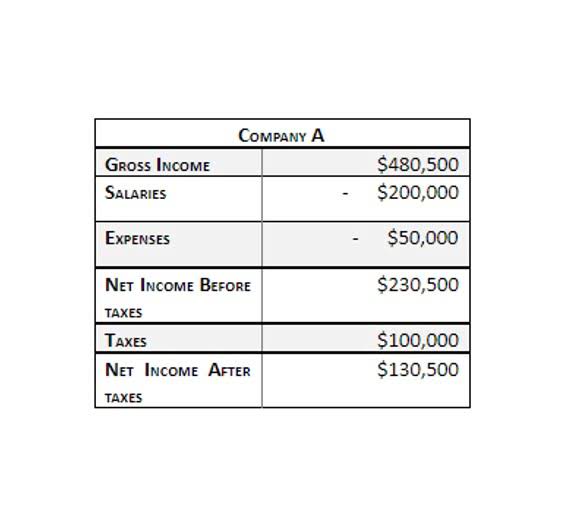
Horizontal analysis is a method of financial statement analysis that compares financial data from one period to another. This technique is used to identify trends or changes in a company’s financial performance over time and can be applied to various financial statements. Horizontal analysis of financial statements can be performed on any of the item in the income statement, balance sheet and statement of cash flows. For example, this analysis can be performed on revenues, cost of sales, expenses, assets, cash, equity and liabilities.

Columbia Business School Executive Education
- It can also help you identify trends and anomalies that may indicate opportunities or risks for the future.
- The vertical analysis considers each amount on the financial statement listed as a percentage of another amount.
- Figure (3) shows a hypothetical balance sheet of Annapurna Textile Inc. as on June 2018.
- The downside of vertical analysis is that it only offers a look at a single period of operations, generally a year.
- Using these insights, organizations can prepare for various financial scenarios, ensuring resilient financial planning and strategic initiatives.
- Horizontal analysis refers to the method of evaluating financial statements over a specified period to identify trends and changes in financial performance.
It shows the proportion of each line item to a base figure, such as total revenue or total assets. For example, you can use vertical analysis to see how the cost of goods sold, operating expenses, and net income relate to the total revenue of a company in a given year or quarter. Vertical analysis can help you evaluate the financial structure, efficiency, and profitability of a company.

Free Financial Modeling Lessons
Understanding these statements is fundamental to performing horizontal and vertical adjusting entries analysis. Common size analysis can be conducted in two ways, i.e., vertical analysis and horizontal analysis. Vertical analysis refers to the analysis of specific line items in relation to a base item within the same financial period.
- The amounts from past financial statements will be restated to be a percentage of the amounts from a base year.
- For example, one-time accounting charges such as expenses for impairment, losses from natural disasters and changes in company structure can impede accurate analysis.
- The income statement can be compared with previous years, and the net income can be compared where it helps to compare and understand the percentage of rising or loss of income.
- Horizontal analysis involves comparing financial data from multiple periods to identify trends, growth patterns, and changes over time.
- In vertical analysis, ratios show how financial items relate to a base figure.
- One advantage of vertical analysis is that it allows for easy comparison between different companies or different time periods within the same company.
Hedge Fund vs Mutual Fund: Difference and Comparison
Examples include inventory turnover ratios and accounts receivable turnover ratios. The following blog discusses further vertical and horizontal analysis, key differences, and other relevant aspects in detail. To illustrate, consider an investor who wishes to determine Company ABC’s performance over the past year before investing. Assume that ABC reported a net income of $15 million in the base year, and total earnings of $65 million were retained. The company reported a net income of $25 million and retained total earnings of $67 million in the current year.

Horizontal analysis is a financial analysis technique that compares financial data over multiple reporting periods to identify trends and patterns in a company’s business cycle. Horizontal analysis involves comparing line items in financial statements across consecutive periods, usually a recent year to a base year. Another form of financial statement analysis used in ratio analysis is horizontal analysis or trend analysis. In financial statement analysis, both horizontal and vertical analysis play pivotal roles. Horizontal analysis helps unveil trends and growth patterns over multiple periods, offering valuable insights for long-term strategic planning.
- Non-profit organizations use them to track fundraising effectiveness and program expense ratios.
- For example, by converting ACME Inc.’s income statement into a common-size format, the finance team can quickly see that COGS makes up 50% of total revenue, and operating expenses represent 20%.
- In the liabilities section, accounts payable is 15% of total assets, and so on.
- This helps in understanding the cost structure and profitability of the company.
- The financial analyst employs a broad range of methods and techniques for company analysis.
- Therefore, it is often used in conjunction with other analytical tools to gain a comprehensive understanding of financial performance.
- Horizontal analysis can be performed in one of the following two different methods i.e. absolute comparison or percentage comparison.
It involves evaluating financial metrics to make informed decisions, assess risks, and Accounting for Technology Companies identify growth opportunities. As businesses face complex economic environments, using effective analytical tools is critical. Like horizontal analysis, vertical analysis is used to mine useful insights from your financial statements. It can be applied to the same documents, but is exclusively percentile-based and travels (as the name implies) vertically within each period across periods, rather than horizontally across periods.

Vertical Analysis of Cash Flow Statement
- They help improve financial statements and strategies when the economy changes.
- For this reason, it is imperative to exercise caution when formulating conclusions in the absence of additional information.
- The ratios tell investors and finance managers how the company is doing in terms of revenues, and can be used to make predictions of future revenues and expenses.
- All balance sheet accounts are presented as a percentage of the total assets and all income statement items are presented as a percentage of sales (Ott, Riddiough, & Yi, 2009).
The business assesses performance on an “apples to apples” basis by comparing each period to a base year, even though the absolute numbers fluctuate over time. In 85% of the companies analysed, the study discovered that normalising data in this manner resulted in more precise performance assessments, thereby enhancing strategic decision-making and financial planning. The value of horizontal analysis enables analysts to assess the company’s past performance and current financial position or growth and project the useful insights gained into the future. However, when using the analysis technique, the comparison (current) period horizontal vs vertical analysis can be made to appear uncommonly bad or good. It depends on the choice of the base year and the chosen accounting periods on which the analysis starts.
